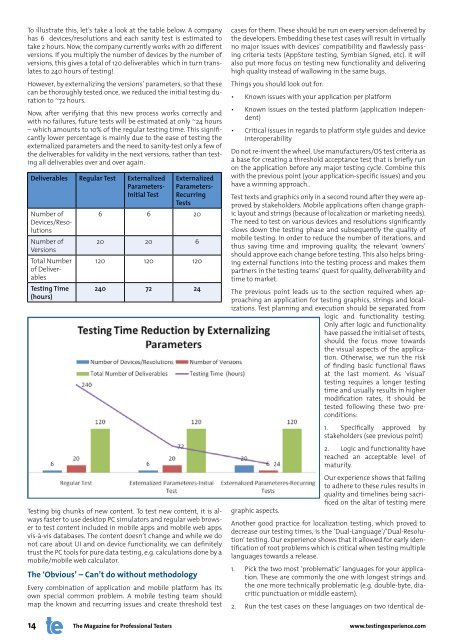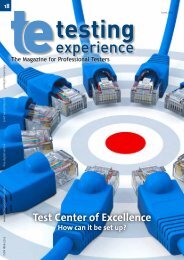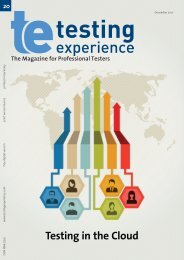Agile Performance Testing - Testing Experience
Agile Performance Testing - Testing Experience
Agile Performance Testing - Testing Experience
You also want an ePaper? Increase the reach of your titles
YUMPU automatically turns print PDFs into web optimized ePapers that Google loves.
To illustrate this, let’s take a look at the table below. A company<br />
has 6 devices/resolutions and each sanity test is estimated to<br />
take 2 hours. Now, the company currently works with 20 different<br />
versions. If you multiply the number of devices by the number of<br />
versions, this gives a total of 120 deliverables which in turn translates<br />
to 240 hours of testing!<br />
However, by externalizing the versions’ parameters, so that these<br />
can be thoroughly tested once, we reduced the initial testing duration<br />
to ~72 hours.<br />
Now, after verifying that this new process works correctly and<br />
with no failures, future tests will be estimated at only ~24 hours<br />
– which amounts to 10% of the regular testing time. This significantly<br />
lower percentage is mainly due to the ease of testing the<br />
externalized parameters and the need to sanity-test only a few of<br />
the deliverables for validity in the next versions, rather than testing<br />
all deliverables over and over again.<br />
Deliverables Regular Test Externalized<br />
Parameters-<br />
Initial Test<br />
Number of<br />
Devices/Resolutions<br />
Number of<br />
Versions<br />
Total Number<br />
of Deliverables<br />
<strong>Testing</strong> Time<br />
(hours)<br />
Externalized<br />
Parameters-<br />
Recurring<br />
Tests<br />
6 6 20<br />
20 20 6<br />
120 120 120<br />
240 72 24<br />
<strong>Testing</strong> big chunks of new content. To test new content, it is always<br />
faster to use desktop PC simulators and regular web browser<br />
to test content included in mobile apps and mobile web apps<br />
vis-à-vis databases. The content doesn’t change and while we do<br />
not care about UI and on device functionality, we can definitely<br />
trust the PC tools for pure data testing, e.g. calculations done by a<br />
mobile/mobile web calculator.<br />
The ‘Obvious’ – Can’t do without methodology<br />
Every combination of application and mobile platform has its<br />
own special common problem. A mobile testing team should<br />
map the known and recurring issues and create threshold test<br />
cases for them. These should be run on every version delivered by<br />
the developers. Embedding these test cases will result in virtually<br />
no major issues with devices’ compatibility and flawlessly passing<br />
criteria tests (AppStore testing, Symbian Signed, etc). It will<br />
also put more focus on testing new functionality and delivering<br />
high quality instead of wallowing in the same bugs.<br />
Things you should look out for:<br />
• Known issues with your application per platform<br />
• Known issues on the tested platform (application independent)<br />
• Critical issues in regards to platform style guides and device<br />
interoperability<br />
Do not re-invent the wheel. Use manufacturers/OS test criteria as<br />
a base for creating a threshold acceptance test that is briefly run<br />
on the application before any major testing cycle. Combine this<br />
with the previous point (your application-specific issues) and you<br />
have a winning approach..<br />
Test texts and graphics only in a second round after they were approved<br />
by stakeholders. Mobile applications often change graphic<br />
layout and strings (because of localization or marketing needs).<br />
The need to test on various devices and resolutions significantly<br />
slows down the testing phase and subsequently the quality of<br />
mobile testing. In order to reduce the number of iterations, and<br />
thus saving time and improving quality, the relevant ‘owners’<br />
should approve each change before testing. This also helps bringing<br />
external functions into the testing process and makes them<br />
partners in the testing teams’ quest for quality, deliverability and<br />
time to market.<br />
The previous point leads us to the section required when approaching<br />
an application for testing graphics, strings and localizations.<br />
Test planning and execution should be separated from<br />
logic and functionality testing.<br />
Only after logic and functionality<br />
have passed the initial set of tests,<br />
should the focus move towards<br />
the visual aspects of the application.<br />
Otherwise, we run the risk<br />
of finding basic functional flaws<br />
at the last moment. As ‘visual’<br />
testing requires a longer testing<br />
time and usually results in higher<br />
modification rates, it should be<br />
tested following these two preconditions:<br />
1. Specifically approved by<br />
stakeholders (see previous point)<br />
2. Logic and functionality have<br />
reached an acceptable level of<br />
maturity.<br />
Our experience shows that failing<br />
to adhere to these rules results in<br />
quality and timelines being sacrificed<br />
on the altar of testing mere<br />
graphic aspects.<br />
Another good practice for localization testing, which proved to<br />
decrease our testing times, is the ‘Dual-Language’/’Dual-Resolution’<br />
testing. Our experience shows that it allowed for early identification<br />
of root problems which is critical when testing multiple<br />
languages towards a release.<br />
1. Pick the two most ‘problematic’ languages for your application.<br />
These are commonly the one with longest strings and<br />
the one more technically problematic (e.g. double-byte, diacritic<br />
punctuation or middle eastern).<br />
2. Run the test cases on these languages on two identical de-<br />
14 The Magazine for Professional Testers www.testingexperience.com









